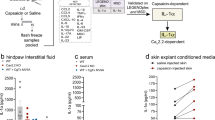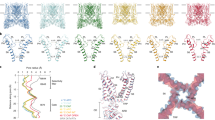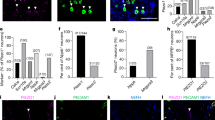Abstract
The vanilloid receptor-1 (VR1) is a heat-gated ion channel that is responsible for the burning sensation elicited by capsaicin. A similar sensation is reported by patients with esophagitis when they consume alcoholic beverages or are administered alcohol by injection as a medical treatment. We report here that ethanol activates primary sensory neurons, resulting in neuropeptide release or plasma extravasation in the esophagus, spinal cord or skin. Sensory neurons from trigeminal or dorsal root ganglia as well as VR1-expressing HEK293 cells responded to ethanol in a concentration-dependent and capsazepine-sensitive fashion. Ethanol potentiated the response of VR1 to capsaicin, protons and heat and lowered the threshold for heat activation of VR1 from ∼42°C to ∼34°C. This provides a likely mechanistic explanation for the ethanol-induced sensory responses that occur at body temperature and for the sensitivity of inflamed tissues to ethanol, such as might be found in esophagitis, neuralgia or wounds.
This is a preview of subscription content, access via your institution
Access options
Subscribe to this journal
Receive 12 print issues and online access
$209.00 per year
only $17.42 per issue
Buy this article
- Purchase on Springer Link
- Instant access to full article PDF
Prices may be subject to local taxes which are calculated during checkout




Similar content being viewed by others
References
Fardy, M.J. & Patton, D.W. Complications associated with peripheral alcohol injections in the management of trigeminal neuralgia. Br. J. Oral Maxillofac. Surg. 32, 387–391 (1994).
Caterina, M.J. et al. The capsaicin receptor: a heat activated ion channel in the pain pathway. Nature 389, 816–824 (1997).
Hayes, P. et al. Cloning and functional expression of a human orthologue of rat vanilloid receptor-1. Pain 88, 205–215 (2000).
Tominaga, M. et al. The cloned capsaicin receptor integrates multiple pain-producing stimuli. Neuron 21, 531–543 (1998).
Zygmunt, P.M. et al. Vanilloid receptors on sensory nerves mediate the vasodillator action of anandamide. Nature 400, 452–457 (1999).
Smart, D. et al. The endogenous lipid anandamide is a full agonist at the human vanilloid receptor (hVR1). Br. J. Pharmacol. 129, 227–230 (2000).
Hwang, S.W. et al. Direct activation of capsaicin receptors by products of lipoxygenases: endogenous capsaicin-like substances. Proc. Natl. Acad. Sci. USA 97, 6155–6160 (2000).
Holzer, P. Capsaicin: cellular targets, mechanisms of action, and selectivity for thin sensory neurons. Pharmacol. Rev. 43, 143–201 (1991).
Bevan, S. et al. Capsazepine: a competitive antagonist of the sensory neurone excitant capsaicin. Br. J. Pharmacol. 107, 544–552 (1992).
Docherty, R.J., Yates, J.C. & Piper, A.S. Capsazepine block of voltage-activated calcium channels in adult rat dorsal root ganglion neurones in culture. Br. J. Pharmacol. 121, 1461–1467 (1997).
Saria, A. et al. Vascular protein leakage in various tissues induced by substance P, capsaicin, bradykinin, serotonin, histamine and antigen challenge. Naunyn Schmiedebergs Arch. Pharmacol. 324, 212–218 (1983).
Forman, S.A. & Zhou, Q. Novel modulation of a nicotinic receptor channel mutant reveals that the open state is stabilized by ethanol. Mol. Pharmacol. 55, 102–108 (1999).
Wick, M.J. et al. Mutations of γ-aminobutyric acid and glycine receptors change alcohol cutoff: evidence for an alcohol receptor? Proc. Natl. Acad. Sci. USA 95, 6504–6509 (1998).
Stubbs, C.D. & Slater, S.J. Ethanol and protein kinase C. Alcohol Clin. Exp. Res. 23, 1552–1560 (1999).
Premkumar, L.S. & Ahern, G.P. Induction of vanilloid receptor channel activity by protein kinase C. Nature 408, 985–990 (2000).
Cesare, P. & McNaughton, P. A novel heat-activated current in nociceptive neurons and its sensitization by bradykinin. Proc. Natl. Acad. Sci. USA 93, 15435–15439 (1996).
Nagy, I. & Rang, H.P. Similarities and differences between the responses of rat sensory neurons to noxious heat and capsaicin. J. Neurosci. 19, 10647–10655 (1999).
Bolanowski, S.J., Gescheider, G.A. & Sutton, S.V. Relationship between oral pain and ethanol concentration in mouthrinses. J. Periodontal. Res. 30, 192–197 (1995).
Liang, Y.-F., Haake, B. & Reeh, P.W. Sustained sensitization and recruitment of rat cutaneous nociceptors by bradykinin and a novel theory of its excitatory action. J. Physiol. 532, 229–239 (2001).
Caterina, M.J. et al. Impaired nociception and pain sensation in mice lacking the capsaicin receptor. Science 288, 306–313 (2000).
Davis, J.B. et al. Vanilloid receptor-1 is essential for inflammatory thermal hyperalgesia. Nature 405, 183–187 (2000).
Yiangou, Y. et al. Vanilloid receptor 1 immunoreactivity in inflamed bowel. Lancet 357, 1338–1339 (2001).
Smid, S.D. et al. Oesophagitis-induced changes in capsaicin-sensitive tachykininergic pathways in the ferret lower oesophageal sphincter. Neurogastroenterol. Motil. 10, 403–411 (1998).
Tognetto, M. et al. Anandamide excites central terminals of dorsal root ganglion neurons via vanilloid receptor-1 (VR-1) activation. J. Neurosci. 15, 1104–1109 (2001).
Acknowledgements
We thank C. Farrant and S. Lomax for preparation of artwork. This work was supported in part by ARCA (Padua) and Cofin (MIUIR, Rome).
Author information
Authors and Affiliations
Corresponding author
Ethics declarations
Competing interests
The authors declare no competing financial interests.
Rights and permissions
About this article
Cite this article
Trevisani, M., Smart, D., Gunthorpe, M. et al. Ethanol elicits and potentiates nociceptor responses via the vanilloid receptor-1. Nat Neurosci 5, 546–551 (2002). https://doi.org/10.1038/nn0602-852
Received:
Accepted:
Published:
Issue Date:
DOI: https://doi.org/10.1038/nn0602-852
This article is cited by
-
Acetaldehyde via CGRP receptor and TRPA1 in Schwann cells mediates ethanol-evoked periorbital mechanical allodynia in mice: relevance for migraine
Journal of Biomedical Science (2023)
-
Identification of Individuals with Functional Dyspepsia With a Simple, Minimally Invasive Test: A Single Center Cohort Study of the Oral Capsaicin Test
American Journal of Gastroenterology (2018)
-
Ethanol’s Effects on Transient Receptor Potential Channel Expression in Brain Microvascular Endothelial Cells
Journal of Neuroimmune Pharmacology (2018)
-
Influence of GABA-B Agonist Baclofen on Capsaicin-Induced Excitation of Secondary Peristalsis in Humans
Clinical and Translational Gastroenterology (2017)
-
The residue I257 at S4–S5 linker in KCNQ1 determines KCNQ1/KCNE1 channel sensitivity to 1-alkanols
Acta Pharmacologica Sinica (2016)



